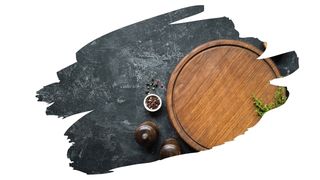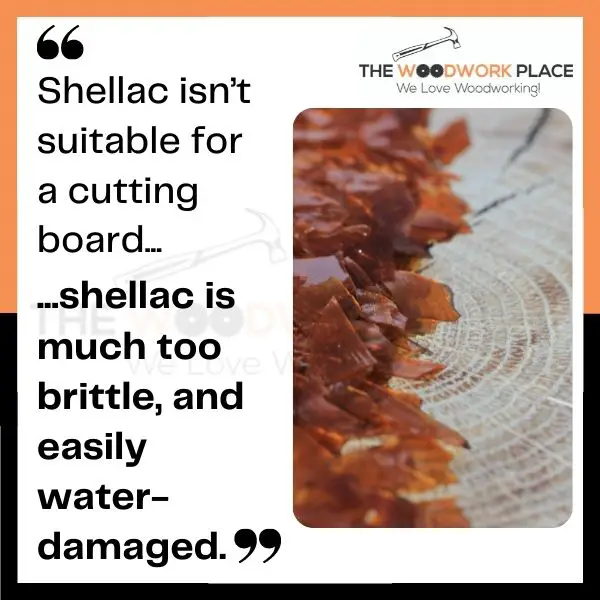Shellac can give any wooden surface a fantastic honey-colored amber coat. That is why shellac has been used as a furniture finish, going back centuries.
And it’s easy to see why shellac is such a long-time favourite. Especially as this quick-drying finish leaves behind an eye-popping high gloss surface.
But, appearances aren’t everything when it comes to finishing a cutting board. A cutting board finish needs to be food safe too.
So, in this post, you will discover what really goes into a shellac wood finish. You will also learn the difference in toxicity between liquid shellac and dried shellac.
And we reveal whether this golden-hued finish can really handle the day-to-day life of a chopping block.

This post may contain affiliate links to products that we receive a commission for (at no additional cost to you). Learn more here.
What Is Shellac Exactly?
Well, Shellac is a bit of a special finish, in that it is naturally sourced. Secreted from lac bugs, (found thriving in parts of Thailand and India), this waxy substance is used in a range of ways.
Beyond being used as a wood sealer, this non-toxic resin is also even used as a food additive. However, when it comes to wood finishing, shellac comes it two forms; dried flakes or liquid.
In dried flake form, shellac will need to be thinned out before it can be applied onto a wooden surface. This typically involves mixing it with high proof alcohol, (not the consumable kind), to get it to melt down.
On the other hand, you can purchase shellac in ready-to-apply liquid form. The manufacturer will have already done the work of thinning out shellac for you. So, all you need do is get to work with a brush.
Is The Dried Version Of Shellac Actually Toxic?
In it’s dried form, its harmless. With no chemical additives included in those flakes, this is shellac in its most pure form.
However, the same cannot be said about the liquid form of shellac. Due to the inclusion of high-proof alcohol in it (plus other chemicals), the liquid version of shellac is too toxic for human consumption.
Does That Mean You Can Put Shellac In Food?
Well, as long as that shellac is US FDA compliant, then it is food safe. That FDA, (The Food and Drug Administration), compliant label means it’s safe for it to be in direct (or indirect) contact with food.
So, US FDA compliant Food Grade shellac is widely used in a lot of confectionery as a food glaze. It gives sweets a tasty looking gleam.
However, any shellac product that has not been clearly labelled as US FDA food grade, is not consumable. So, liquid shellac is not edible in anyway shape or form.
And Why Is Liquid Shellac So Toxic?
Well, liquid shellac has been thinned out using something called ethyl alcohol. This plant-sourced alcohol comes from the same fermentation process that gives us wine and beer.
But, when it comes to shellac, the alcohol found in beer is not strong enough to melt down those flakes. Instead, only alcohol that is 95% proof (or higher) can break down and thin out shellac.
Related Post: Thinning Shellac With Mineral Spirits Won’t Work (Here’s What Will)
This is why liquid shellac is ideally thinned out using Denatured Alcohol. When applied topically, denatured alcohol doesn’t burn or damage your skin.
However, if it is ingested, it can give you severe alcohol poisoning. So, if you were to drink shellac in its liquid form, you run the risk of suffering from severe alcohol poisoning too.

But, Can You Use Shellac On Cutting Boards?
Not quite. You see, shellac isn’t a very durable finish for three key reasons;
1). Shellac Is Very Brittle
Cutting boards have a tough life. All of that chopping and slicing means that cutting boards are made from fairly hard lumber.
And yet, shellac is an easily scratched finish. And it certainly won’t last on a regularly used cutting board.
2). Shellac Is Easily Heat Damaged
Place hot food (such as a well cooked steak) on this finish, and you will damage it. That is because shellac can only handle temperatures of up to 120°F (48.9°C), before melting.
3). Shellac Is Easily Washed Off
Shellac is water-resistant, but it is not waterproof. Washing a cutting board will damage a shellac finish, and likely cause ‘blushing’. Blushing refers to whenever a shellac finish gets water (or moisture) trapped in it.
What’s more, a lot of cleaning solutions contain substances that can even dissolve away shellac. Substances such as ammonia, high proof alcohol, and even certain soaps, can melt away a shellac coat.
So, What Can You Use On Your Cutting Board Instead Of Shellac?
Simply use 100% pure food grade mineral oil to seal and protect a cutting board.
Mineral oil will enhance the look of wood grain just as well as a shellac finish. However, unlike shellac, mineral oil will not form a brittle coat on the surface of your cutting board.
As a non-drying oil, mineral oil acts like a water-repelling wood preservative. But, unlike a lot of wood finishes, it does not solidify and harden.
But, the best thing about pure food grade mineral oil is the fact that it is non-toxic. This product is safe for human consumption, because it is made from highly refined petroleum distillate.
So, if it accidentally manages to get into the food you’re preparing, it won’t make you ill.
Related Post: Walnut Oil Vs Mineral Oil: Which One’s Better For Your Cutting Board?
To Wrap Up, Here Are The 3 Key Takeaways From This Post…
- 1). Pure shellac is non-toxic. Not only is this naturally-source resin a great looking wood finish, it is also used as a food glaze.
- 2). Liquid shellac wood finish, (that has been thinned out with alcohol), is not safe for human consumption.
- 3). Shellac isn’t a suitable wood finish for a regularly used cutting board. That’s because shellac is much too brittle, and is easily water-damaged.
References:
Hagenmaier, Robert D., and Philip E. Shaw. “Permeability of shellac coatings to gases and water vapor.” Journal of Agricultural and Food chemistry 39.5 (1991): 825-829.
Srivastava, S. A. N. J. A. Y., and N. A. N. D. K. I. S. H. O. R. E. Thombare. “Safety assessment of shellac as food additive through long term toxicity study.” Trends Biosci 10 (2017): 733-740.
Derrick, Michele R.; Stulik, Dusan C.; Landry, James M.; Bouffard, Steven P. (1992). “Furniture finish layer identification by infrared linear mapping microspectroscopy”. JAIC (Journal of the American Institute of Conservation). 31 (2, Article 6): 225 to 236



![Why Are There Bubbles In My Shellac Wood Finish? [+ How To Get Rid Of Them] bubbles in shellac wood finish](https://www.thewoodworkplace.com/wp-content/uploads/2022/10/Banner-499-150x150.jpg)